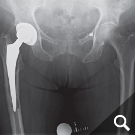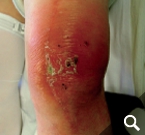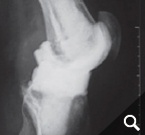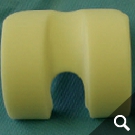Infection
Ansprechpartner
-
OA Dr. med. S. Illiger
Contact: Send E-Mail
Special Consultation Hours
Fortunately, the number of bone and joint infections in Germany is low. However, if a patient is affected by such a disease, this represents a major challenge for him/her and for the person treating him or her. The treatment is a real emergency situation that does not tolerate any delay. On the other hand, it is very important that a specific therapy takes place in a highly specialized center.
Generally, a distinction is made between acute and chronic infection. A form of chronic infection, the so-called low-grade infection, can also be the reason for premature loosening of the prosthesis. Since the bacteria multiply slowly, this infection is so weak that it is hardly noticed by the patient and also eludes laboratory tests, since it causes hardly any changes in the blood.
In order to diagnose these infections, tissue samples are taken from the joint in addition to a puncture, as only close cooperation between orthopedists, pathologists and microbiologists can ensure the correct diagnosis. In addition, we also devote ourselves to obviously infected prostheses, of course. These infections can occur shortly after the operation (so-called early infection up to 6 weeks postoperatively) but also years after the operation (as so-called late infection). In addition to the smallest entry points (e.g. an ulcerated toenail), serious infections such as pneumonia can also lead to bacteria colonizing the surface of the prosthesis. Patients with a limited immune system (e.g. diabetics, rheumatics) are particularly at risk. If an infection is noticed early enough after surgery, it is occasionally still possible to eliminate the infection without removing the prosthesis by carefully cleaning the wound and changing the moving parts.
However, infections often go unnoticed for many weeks, so that removal of the prosthesis is unavoidable. Depending on the pathogen and its sensitivity, a placeholder containing antibiotics is then implanted, which remains in place for 6 weeks. Antibiotics in tablet form must then also be taken for this period. However, it is not necessary for a patient to remain in the hospital during this entire period. If home care is not possible, for example, it is also possible to organize this in close cooperation with our social services. After 6 weeks it is generally possible to reimplant a prosthesis, provided that the blood values show that the infection is under control. Antibiotics must then be taken again for 6 weeks after surgery. Which antibiotics are taken is determined in close cooperation with colleagues in microbiology and clinical pharmacology, with whom regular rounds and therapy checks are carried out. These therapeutic measures are carried out in a special area of the clinic using the most modern methods.
Due to the excellent collaboration of many disciplines with an optimized therapy for the patient, the risk of suffering a new infection is significantly reduced.










